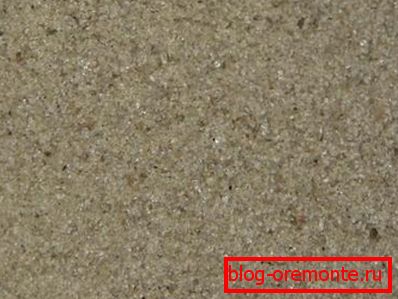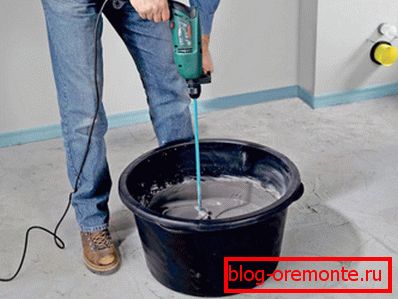Cast concrete and its features. differences from standard
Concrete is one of the most popular building materials, which is used in various areas of construction. This is primarily due to the great diversity of its species, each of which has its own specific characteristics. Such varieties include cast concrete, to which this article is devoted.

Features of cast concrete
General information
Cast concrete is a building material that is classified as hydraulic. In hardware stores, it is sold as a powder consisting of the following components:
| Portland cement M400 or М500 | As a result of high fineness of grinding and optimal grain size distribution, these cements have excellent water holding capacity at high W / C values. |
| Sand | The most commonly used sand is fines, as they move better in solution, as a result of which its fluidity increases. |
| Plasticizers, air-entraining or water-retaining additives | Responsible for ductility and other special material properties. |
Of course, the composition of different types of cast concrete may vary, however, the foregoing basis always remains the same.

Differences of cast concrete from the usual
At first glance it may seem that this material is no different from ordinary concrete, however, there are still differences. They consist primarily in the presence of polymer modifiers, which are part of it.
Thanks to them, concrete acquires the following properties:
- It becomes more elastic;
- The level of shrinkage is reduced;
- Well spreads and levels out;
- It becomes more waterproof and frost-resistant.
It should also be noted that some types of cast concrete contain anti-frost additives, which allows you to perform concrete work at negative temperatures. And up to what temperature concrete can be cast depends on the type of anti-frost additive.
In addition, in some cases, the composition of the mixture may include additives that retain moisture, as a result of which the solution can be adjusted for a longer time.

The main difference is cast concrete is its scope. The material is intended for casting such places where the casting of concrete of the usual type is difficult, for example, where it is impossible to use vibration settings.
In addition, the material is used in the following areas of construction:
- When concreting stairs.
- In the production of precast concrete.
- In ameliorative construction.
- When pouring warm floors. It should be noted that any floor covering can be laid over such floors.
- When performing cast concrete products. In this case, the solution is poured into special molds for casting from concrete.
Tip! If you add bitumen to the composition, you will get an asphalt-cast concrete mix, i.e. excellent road surface.

Virtues
In addition to all the above features of the material, it is possible to distinguish the following advantages:
- Due to the high ductility, do-it-yourself fill is quite simple.
- There is no need to condense the mixture filled with vibrating plants.
- The material is resistant to moisture, as a result of which it can stay in the ground for a long time and for some time directly contact with water. Therefore, it is used in the construction of foundations. Most often, cast concrete M300 is used for these purposes.
- The polymers that make up the solution allow the material to tolerate sudden changes in temperature.
disadvantages
As for the disadvantages, they include a high level of impurities (up to 5 percent), the cost of which is quite high. As a result, the price of the material is quite high.

Cast concrete application
Preparation of the solution
Preparing cast concrete from a dry mix is quite simple. To do this, you need two tanks with a volume of about 40 liters and a construction mixer or a drill with a nozzle.
Work is performed in the following sequence:
- Water should be poured into one of the containers and a dry mixture into the other.. The amount of water depends on the proportions. Exact information about the proportions contains instructions on the packaging of the mixture.
- Then the mixture should be gradually poured into water and constantly stirred.. In no case can not add water to the dry mixture, as this will lead to the formation of lumps, from which it is very difficult to get rid of.
- After the solution is ready, leave it for five minutes and then mix again..
Note! In the process of preparing the solution, it is extremely important to respect the proportions. If you add water to the finished solution, it will ruin it completely.
The process of preparing the solution is completed. Working with him is about 20 minutes. Accordingly, it is necessary to prepare concrete in small portions in order to have time to spend it.

Fill
If you plan to perform a casting of concrete, then there is nothing difficult in this - it is enough to pour the solution into the molds and wait for it to dry.
But, if it is necessary to pour the foundation or to perform a tie, then this operation involves a number of actions:
- Work on pouring concrete should begin with preparing the surface that is planned to be filled with mortar. To do this, remove dirt, remnants of building materials and dust. If the foundation is fulfilled, the bottom of the trenches is filled with sand and compacted.
- Next is the removable formwork of wooden boards or chipboard sheets. Often when filling the foundation, beginner masters are interested in - is it possible to pour concrete into the ground? This option is allowed if the soil is not heaving and the trenches are dug exactly.
In this case, the walls of the trenches are lined with roofing felt or film, however, the formwork of the desired height is still performed above the ground.

- To give the material greater strength perform reinforcement. Depending on the type of construction, reinforcement can be made with a special mesh or metal rods.
When performing reinforcement, protective layers should be taken into account, i.e. From the metal frame to the surface of the concrete must remain a certain distance. Therefore, under the frame enclose, as a rule, wooden bars. If a screed is made, the reinforcement mesh should be in the middle of the concrete column.
- After all the preparatory stages are completed, you can proceed directly to pouring the solution. An important point is the ambient temperature. Before pouring it is necessary to read the instructions, how many degrees you can pour concrete.
If the temperature is too low, the water in the solution will freeze, and the material will deteriorate. If, on the contrary, the temperature is too high, the liquid will quickly evaporate, causing the concrete to crack.
- A few days after pouring you need to remove the formwork. Full freezing of concrete occurs after 28 days.

Note! After pouring the concrete it is necessary to ensure its even hardening. To do this, for the first ten days the concrete surface is wetted with water. If hardening occurs in conditions of elevated temperature, the structure should be covered with a wet burlap.
That's all the features of cast concrete, knowing that you can apply this material in private residential construction, as well as for some other purposes.
Conclusion
Cast concrete is one of the most popular types of concrete, since its area of application is very extensive. The only thing that the material conforms to the characteristics declared by the manufacturer, it is necessary to follow certain rules for its use.
From the video in this article, you can get more information on this topic.